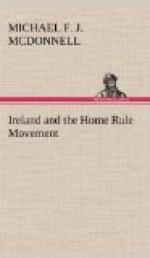By the Act of Union, which our opponents hold so sacred, Ireland was given 100 members in the House of Commons, and in the House of Lords 28 representative Peers, together with Bishops of the then Established Church, and it was further enacted that this should be her representation “for ever.” On the population basis, which to-day is urged by Unionists as the only fair mode of apportioning representatives, Ireland was entitled at the date of the Union to many more members than in fact she obtained. Her population at that time was nearly five and a half millions, that of Great Britain was less than ten and a half millions, and so, though she could claim more than a third of the inhabitants of the three kingdoms, her representation was less than one-sixth.
By the Reform Bill of 1832 the Irish members were increased to 105. Two seats have since been disfranchised, and we thus arrive at 103—the figure at which the representation of the country stands to-day. The disproportion from which Ireland suffered at the time of the Union had become still more acute by the time of the great Reform Bill, and no one can seriously suggest that the addition of five seats redressed the inequality. According to the Census of 1831 the population of Great Britain was little over sixteen millions, and that of Ireland was seven and three-quarter millions. If these figures had formed the basis of a proportionate representation, Ireland would have had a little more than 200 members—just about double the number which she actually returned.
By an agreement between parties, as I have said, in the last Redistribution of Seats Bill—that of 1885—the number of representatives of Ireland was left unchanged, and it is only since the Conservative Party has definitely thrown in its lot as an opponent of Irish demands as formulated to-day that this method of reducing the force of their political opponents has begun to find favour amongst its members: Under the Bill of Mr. Gerald Balfour, by an ingenious arrangement of raising the limits of population under which boroughs and counties should no longer have separate representation, the scheme secured the transfer of twenty-two seats from Ireland to Great Britain.
The limit of population above which boroughs would have had to reach to maintain their separate existence was fixed at 18,500, and under this arrangement three boroughs in Ireland and six in Great Britain would have lost their seats. If the limit had been fixed at 25,000 a total of 19 seats in Great Britain and still only 3 in Ireland would have lost their member, while a minimum population of 35,000 would have disfranchised 25 boroughs in Great Britain and only 4 in Ireland.
The actual proposal was elaborately calculated so as to produce the least possible disturbance to the small boroughs in Great Britain, while securing the maximum of disfranchisement in Ireland.
At the same time the standard of population per member, which in the case of counties was fixed at 65,000, secured the disfranchisement of one Scottish county, the net disfranchisement of two English counties, and the deprivation of no less than 20 Irish counties of their member.




